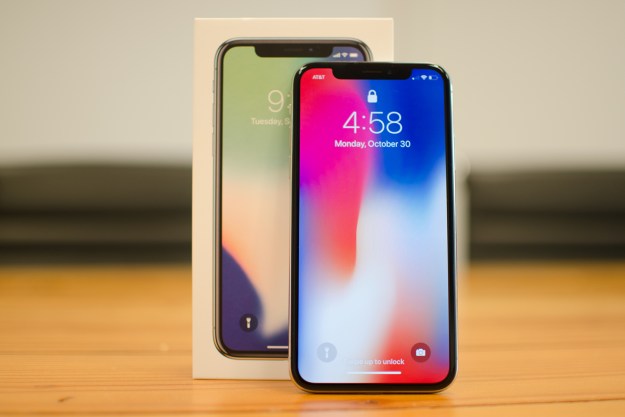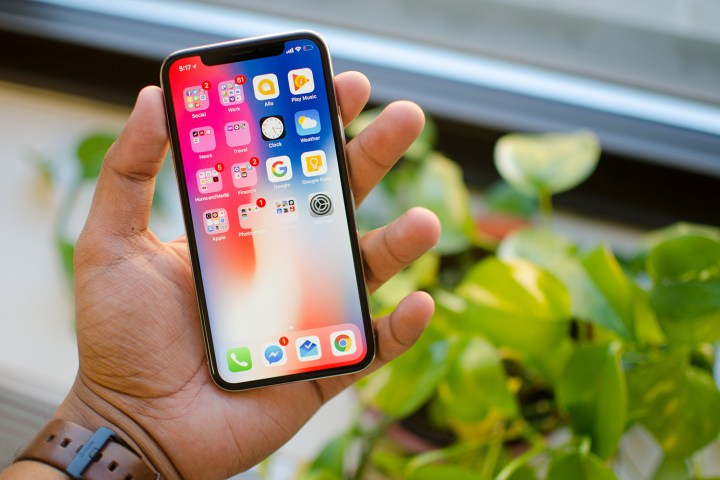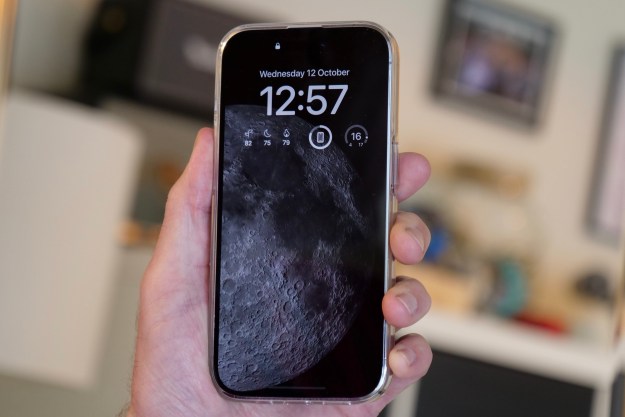
“The iPhone X is the iPhone to buy this year.”
- Jawdropping OLED screen
- Unsurpassed speed
- Top-tier camera
- Innovative industrial design
- Wireless charging
- Awkward notch can break immersion
- Expensive
Apple’s 10th anniversary iPhone X sets a new gold standard for the next decade of iPhones. Coming hot on the heels of the iPhone 8 and iPhone 8 Plus, the iPhone X stole the show despite sharing nearly identical internal hardware. The X (pronounced “ten,” like the Roman numeral) is a beautiful, modern sculpture, and iPhone owners finally have a reason to show off their phones again.
As we’re now about four months from Apple’s next iPhone launch, we’re revisiting the iPhone X to see if this smartphone is still worth the high price tag.
A stunning display
Turn on the iPhone X, and it’s easy to forget almost every other phone released over the past year. Apple didn’t kick-start the “bezel-less” smartphone design trend, where the edges around the screen melt away to offer an immersive all-screen experience, but it certainly helped popularize it. Other phones may have slightly smaller bezels, but we do like the approach Apple took here.
Most of the time, anyway. The controversial notch cut out at the top of the screen accommodateing the front-facing camera continues to split opinion, especially as it’s now on more phones. The notch on the Essential Phone is smaller, but doesn’t contain the same depth-sensing sensor technology as the Apple phone. It all becomes inconsequential after using the iPhone X for more than a few days, just as with any other notched display. It takes some getting used to, but it’s not the irritation many want to believe it is. It helps that iOS gracefully splits the top status bar in half around the notch, and many native apps also tailor their designs to it, but it’s easy to feel a break in immersion when watching YouTube videos and movies on Netflix.
When the iPhone X first launched, many apps did not support the full display. More than a month after its release, most popular apps support it, but even six months in, there are still many that don’t. Developers continue to update apps, but definitely not at the pace we want.
- 1. iPhone X with an unsupported app.
- 2. iPhone X with a supported app.
The OLED display goes a long way in making amends for these quibbles. The 5.8-inch screen has a 2,436 x 1,125-pixel resolution (458 pixels per inch), and it’s razor sharp. Colors are vibrant, blacks are finally as pitch-dark as many other OLED Android phones, and it’s easy to read in direct sunlight. You’ll have a hard time pulling your eyes away from this screen.
The X is a beautiful, modern sculpture, and iPhone owners finally have a reason to show off their phones again.
As on the iPhone 8 and iPad, Apple’s True Tone technology detects the lighting condition you’re in, and adjusts the screen’s tint to make it more readable. It works extremely well, and made the screen warmer — and easier on the eyes — in our harsh office lighting. Over time, its alterations are almost unnoticeable until you stare at a screen without it. It’s the definition of an invisible technology that just does its job really well, without any fuss.
The phone’s all-glass rear is almost the same as the iPhone 8 Plus, except the dual-camera setup has turned to a vertical orientation. Apple says the front-facing depth sensors and cameras took up a lot of space up top, and the rear camera wouldn’t fit sideways. With only the Apple and iPhone logo printed on the glass, the back looks minimal and sleek. The vertical orientation is a dead giveaway you have the iPhone X, but other manufacturers including Huawei are adopting a similar style, making it less unique as time passes.
One noticeable difference is the power button, which now perhaps should be called the “lock button.” Still situated on the right edge, it’s more elongated than before, which makes it easier to find and press. We say lock button because to turn off the iPhone X, you need to press the lock button and the volume up or down buttons. Tapping on the lock button just wakes or turns off your screen, but you can double tap it to activate Apple Pay, or press and hold it to launch Siri.
The mute switch is on the top left, and the volume rocker sits below. There’s still no headphone jack, and the only port is for your Lightning cable at the bottom edge, between the bottom-firing speakers. For music, you’ll either have to pair wireless headphones, either with the Bluetooth 5 technology on board or not, or you can embrace the dongle life with the included Lightning to 3.5mm headphone jack adapter.
What may surprise many about the iPhone X is its size. It feels compact — it’s slightly larger than the 4.7-inch iPhone 8, but it has a bigger screen than the 5,5-inch iPhone 8 Plus. The X is comfortable in the hand, and it feels remarkable to have so much more screen real estate than a cumbersome “plus-sized” phone. However, despite the larger screen size the iPhone X doesn’t feel as big as the iPhone 8 Plus, as the additional screen real estate is all vertical, rather than adding horizontal space too. It’d be unfair to call the iPhone X’s screen too small; but many will welcome a larger iPhone X Plus in the future.
Speedy and a gesture-based iOS
You’ll find the same A11 Bionic processor from the iPhone 8 and 8 Plus powering the iPhone X. Performance is excellent — the interface is fluid, and switching between apps is fast. Games like Monument Valley 2, Transformers: Forged to Fight, and the augmented reality game The Machines ran smoothly. This has not changed after six months with the iPhone X. Our iPhone X benchmark scores reaffirm our experience.
- AnTuTu: 206,010
- Geekbench 4 CPU: 4,231 single-core; 9,877 multi-core
The AnTuTu score is slightly less than what we’ve seen on our iPhone 8 and 8 Plus, which received respective scores of 214,492, and 222,462. At the time of release, it was higher than any other Android smartphone we’d tested, including the Google Pixel 2, which scored 146,876. Since then, the Samsung Galaxy S9 Plus received 263,517, while the Huawei P20 Pro just beat the iPhone X with a score of 210,342. Geekbench scores were nearly identical against the iPhone 8 and 8 Plus, and even today absolutely eclipses the Android competition. None of these Android phones are slow, as many of them offer excellent performance.
The iPhone X also introduces a new way to interact and navigate with iOS. If you noticed, we didn’t mention a home button earlier — it’s officially no more. What replaces it? Gestures. Access the Control Center by sliding down from the top right shoulder, and pull down the Notification Center from the center notch area. If you’re in an app, you’ll see an elongated bar at the bottom: Swipe it up to go back to the home screen.
If you swipe it up and pause, you will see all your previous apps for some quick multitasking. You can also switch between apps by sliding your finger from the bottom left to the bottom right, kind of like drawing an upside down U. All the animations are beautiful and responsive. There is a learning curve, especially if you’ve used iOS before; but you soon speed up, and the gestures become very natural. It’s not really suited to one-hand use in all situations, and it’s frustratingly easy to open the Notification Center rather than the Control Center if you’re not using two hands.
Hardware actions are also different. Trying to quietly activate Siri? Just tap and hold the lock button. Taking a screenshot is easy too — tap the lock and volume up buttons at the same time. Actually too easy, and we often take screenshots when changing the volume as we pick up the phone. We do like the fast access to mark screenshots up, which is performed just by tapping the image that appears in the bottom left of the screen. You can press and hold the lock and volume down button to turn off the iPhone, or to access SOS emergency services, and double-tapping the lock button brings up Apple Pay.
These gesture-based interactions are a thoughtful way of navigating the home button-less iPhone X. The animations are slick, fluid, and futuristic. iOS 11 also brings a whole lot more customization, such as the redesigned Control Center, and you can check out our in-depth iOS 11 review to see what’s new.
Face ID and Animojis
Face ID is the hallmark of the iPhone X, and a huge gamble for Apple, since it completely replaces Touch ID. Instead of swiping a fingerprint, just look at your phone, and it unlocks.
In our initial review, we didn’t think it worked well and found it slower to be Touch ID. It has since improved greatly, and Apple told us there’s a quicker way to use Face ID. Rather than raising the phone, waiting for the padlock to unlock, and then swiping up to go to the home screen, simply swipe up the lock screen when you want to go to your home screen. You’ll see a quick Face ID animation — if it recognizes you — and voila, you’re through.
That’s fine, but it doesn’t help when you want to glance at lock screen notifications, which are hidden until the phone “sees” your face. If Face ID misses you the first time, it doesn’t look again unless you sleep and re-awaken the screen, adding a frustrating extra step to just seeing your messages. Alternatively, you can swipe to unlock, and then dig into the Notification Center. Annoying if you only wanted to see if a notification was worth your time.
Apple said Face ID gets better over time because it’s continually updating its model of you, which is why it recommends to never reset your Face ID profile, and we’ve been impressed with its ever-improving speed.
It works incredibly well in the dark, which is surprising, but you’ll always want to make sure you aim the front camera towards your face and don’t hold it too close. It can get a little tricky with certain angles, and so it’s likely better to use a pass code when it’s lying flat on a desk. We also find that using it with Apple Pay requires extra care to let the phone see your face. You either have to loom over the screen while it’s held close to a reader, or activate Apple Pay, move the phone so it can see you, then move it back to the reader. The iPhone X prompts you at every step.
We like it over Touch ID. It’s convenient — you don’t need to take your gloves off to access your phone in the winter, for example. It’s also still the most secure facial recognition system available on a phone. Almost all Android phones using some type of “Face Unlock” have stressed that it’s purely meant for convenience, and not security.
The other big feature you can use Face ID’s 3D-mapping sensors and cameras for is Animoji. Open the Messages app and you’ll find a new option to send an animated emoji to a friend, or an Animoji. It tracks your facial expressions — with surprising accuracy — and records whatever you say, kind of like motion capture used in movies. You can send this to anyone, on Android or iOS, and they’ll be able to see it because it’s a standard video file. It’s a fun feature, but it’s not necessarily a reason to buy the iPhone X.
It would be great if you could send Animojis to people through different messaging apps; but other companies are introducing their own versions. Samsung introduced AR Emojis with the Galaxy S9, but they’re not as accurate or cute as Animojis, proving how much difference the depth-sensing technology makes on the iPhone X.
Another great camera
The iPhone X has a very similar camera to the iPhone 8 Plus: Both feature a 12-megapixel wide-angle lens with an f/1.8 aperture, but the 12-megapixel telephoto lens has a wider f/2.4 aperture over the 8 Plus’ f/2.8 aperture. This helps in low light situations with 2x optical zoom, as well as Portrait Mode as it uses the telephoto lens.
Both cameras also have optical image stabilization, a first for Apple. It helps prevent blurriness with shaky hands when you’re zooming in on objects with the optical zoom. It also can improve photos taken in Portrait Mode, as it relies on the telephoto lens.
- 1. Pixel 2 XL
- 2. iPhone X
The rear camera is undoubtedly stellar. It offers great color accuracy, lots of detail, and best of all, virtually no shutter lag. Launch the camera, tap the shutter icon, and the iPhone X will take photos faster than you can say “Cheese!” In brief comparisons with our favorite camera phone, the Google Pixel 2, we did find Google’s Android phone to feature better dynamic range and slightly more detail. You can check out our large-scale camera test to see how the iPhone X stacks up against the competition.
You won’t see much of a difference between the iPhone X against its predecessors, namely the iPhone 8 Plus and the iPhone 7 Plus. We’ve added some comparisons below.
iPhone X:
iPhone 8 Plus:
iPhone 7 Plus:
Overall, we liked the iPhone X’s photos the most, though you’ll really have a tough time telling them all apart. In low-light scenarios, the iPhone X edged out with sharper images and less grain — especially in Portrait Mode. The iPhone X and the iPhone 8 Plus dealt with dynamic range better than the iPhone 7 Plus; for example, the iPhone 7 Plus’ photo with the cars on the road is too dim overall, whereas the iPhone 8 Plus and X brighten the foreground without overexposing the background sky. We did like the color accuracy on the iPhone X and the 7 Plus more than the 8 Plus (except in low light), which made photos look a littler more reddish than normal.
Portrait Mode adds a blur behind a subject, offering a DSLR-like look, but the star feature is Portrait Lighting, which lets you fake different studio lighting options. This was first introduced with the iPhone 8 Plus, but our eyes are on what the iPhone X brings — Portrait Mode and Portrait Lighting to the 7-megapixel front-facing camera. You can finally make those selfies look far more professional, and the iPhone X does a solid job. It works just as advertised, but the output isn’t as good as the rear dual-camera setup, especially when it’s trying to detect hair. Take a look:
The iPhone X’s blur is strong, and it looks very natural like a DSLR. It has trouble dealing with dynamic range, such as in the last Portrait Mode selfie photo in the park, where the background is overexposed; as well as in the photo of the fence. Hair, especially with the selfie camera, gets messed up easily and is often blurred. The rear camera can make mistakes too, of course, as seen in the photo with the leaves of the tree. Some of these subjects are complicated, though, so it’s understandable when it does trip up.

Overall, the iPhone X’s cameras let you do so much more than ever before, and the results are almost always still impressive. Our favorite part still remains the ease, accessibility of using the camera — it’s incredibly quick, and we’ve hardly ever seen any shutter lag. However, camera technology inside smartphones has seen dramatic improvements over the past months, especially in lowlight, and although the iPhone X is great, its ability has been surpassed by the Galaxy S9 Plus and the Huawei P20 Pro. See our iPhone X, P20 Pro, Galaxy S9 Plus, and Pixel 2 camera comparison to see by how much.
Battery
Battery life on the iPhone X has been fairly average, and its ability to last the day greatly depends one what you’re doing. Under general use, most days end with 30 percent remaining, based on taking photos, app use, browsing the web, and responding to notifications. General use with Bluetooth music streaming, and an hour or so of Google Maps use, will see the battery die well before the end of the day. The iPhone 8 Plus returns better battery life.
Just as with the iPhone 8 and 8 Plus, the iPhone X’s glass back makes it compatible with the Qi wireless charging standard. Just plop your phone down on a charging pad and you’re juicing it up — no cables needed. We’ve experimented with wireless charging using different phone cases, and have not experienced any problems. However, it does require quite careful placement on the charging mat, and the slightest nudge can stop it charging. Again, this varies depending on your choice of case and wireless charger; but it’s something to be aware of.
All three new iPhones support fast charging, but not with the included charger. If you own a modern MacBook, the included 29w charging block and a USB-C to Lightning cable will do the job; but if not you’ll have to buy the charging block from Apple too. It’s a pricey endeavour, but Apple promises a 50 percent charge in 30 minutes, so it’ll be worth it for some. However, we’re disappointed it didn’t include an adequate fast charger in the box.
Price, availability, and warranty
The iPhone X is expensive. The 64GB model starts at $1,000, and the 256GB variant will set you back $1,150. They’re available for purchase now. Too rich for your blood? Check out the best iPhone deals for savings.
We’ve also rounded up the best smartphone deals if you’re looking for other affordable alternatives.
Apple offers a standard warranty that protects your device from manufacturing defects one year from the date of purchase. You can grab AppleCare+ insurance, which includes two years of technical support and accidental damage coverage. We recommend using a case and a screen protector as the display can be quite costly to replace.
Our Take
The iPhone X is the iPhone to buy. It’s well worth the high price tag, and there’s no doubt Apple fans will love the entire ownership experience.
Is there a better alternative?
For iOS users, your best alternatives are the iPhone 8 and iPhone 8 Plus. They’re a little more affordable, and they pack nearly identical specifications as the iPhone X. You’re largely missing out on the new design, Face ID, and Animojis of course. If you’re willing to spend close to $700 for the iPhone 8, we think it’s worth splurging a little more on the X.
Keep in mind Apple is still selling older iPhones. If you don’t need the latest design, fun camera, or Face ID, and just want an iPhone that works, you should consider the iPhone 6S and iPhone 7, which start at low prices from Apple. We should note, the older the iPhone, the fewer years of updates you’ll have left.
If you’re willing to swap to Android, there are plenty of good choices. We recommend the Google Pixel 2 and Pixel 2 XL, because you won’t find comparable hardware and software integration, like Apple, anywhere else. The 2018 line-up of Android smartphones is very tempting, especially the Samsung Galaxy S9 Plus — which we recommend over the Galaxy S9 for the dual-lens camera — and the Huawei P20 Pro, if it’s sold where you live.
How long will it last?
The iPhone X is IP67 water-resistant, meaning it can stay underwater up to 1.5 meters for 30 minutes. Apple said the rear and front glass is incredibly durable and strong, but it’s still glass. It will likely shatter after a drop on concrete.
Unlike with most Android phones, you’ll get fast version and security updates with the iPhone X. The device will also be supported for four to five years before it stops getting software updates. We expect the iPhone X to last four to five years.
Should you buy it?
Yes. If you’re an Apple fan, this is the phone to buy. We can’t peel our eyes away from the gorgeous OLED screen, and using gestures to move around iOS is pure bliss.
Updated on May 9 by Andy Boxall: Revised various sections to include iPhone X impressions after six months of use. No change to score.
Editors' Recommendations
- Apple is about to do the unthinkable to its iPads
- AirTags range: here’s how far the tracker can reach
- An Apple insider just revealed how iOS 18’s AI features will work
- The most common Skype problems and how to fix them
- iPhone 16: news, rumored price, release date, and more








































